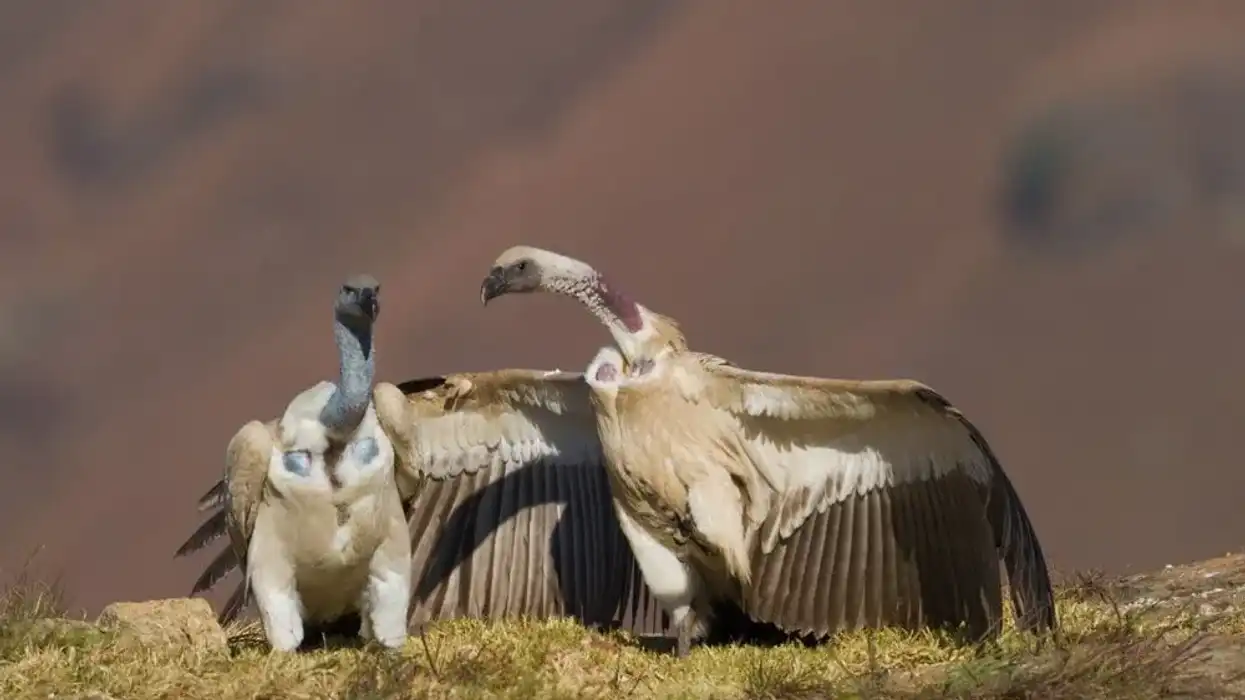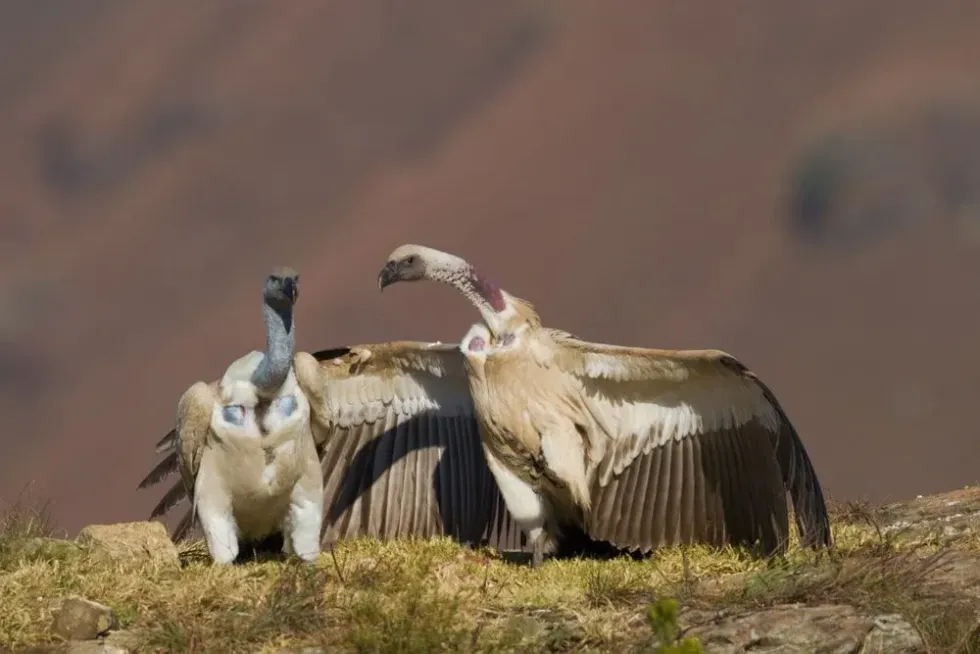Cape vulture, also known as Cape griffon or Kolbe's vulture, is one of the nine vulture species found in Southern Africa. They are one of the strongest scavengers compared to other land scavengers. They have sharp long-distance sight, which allows them to track their prey from a wide range.
They feed on carcasses. They are off-white in color with dark brown beaks and wing feathers. Their head and neck are almost bare-skinned, with no feathers. This species builds its nest on high cliffs and mountainous regions.
They breed only once a year. Their conservation status is labeled as Vulnerable, which means that they have an increased risk of extinction. This is why they need more protection.
Cape Vulture Interesting Facts
What type of animal is a Cape vulture?
Cape vultures or Cape griffons are giant dark brown birds primarily found in South Africa. These vultures are also known as scavengers who prey on animal carcasses with an attack range of long distances.
Cape griffon birds are among the largest raptors in various breeding colonies. Their habitat includes grasslands, savannahs, and different other wooden areas. They come under the class of Aves and are included in the family Accipitridae.
What class of animal does a Cape vulture belong to?
Cape vulture (Gyps coprotheres) belongs to the class of birds. This means they are endothermic (warm-blooded), lay eggs, have two feet, and fly. Their bare skin is covered with fur all over the body, except the legs and head. Their metabolism rates are pretty high.
This species has a beak as its mouth with no teeth. Their bodies are lightweight, which allows them to fly. However, they have a strong skeleton.
How many Cape vultures are there in the world?
According to the IUCN (International Union for Conservation of Nature), there are about 9,400 Cape vultures left in the world. The population of these Cape griffons is decreasing.
They are endangered due to threats of human intrusions, severe climatic changes, variations in ecosystems, and hunting and trapping. Various conservation steps are being taken to spread awareness, and feeding areas are being set up in southern colonies to provide food and nutrition to these vultures.
Where does a Cape vulture live?
Cape vultures live in the terrains of South Africa. They are also found in Lesotho, Botswana, and Mozambique. Earlier, these birds also lived in Swaziland, Zimbabwe, and Namibia.
However, they are now extinct in Swaziland and are in a rare non-breeding number in Namibia and Zimbabwe. They are also found in mountainous regions. Cape griffon lives in large colonies of six pairs and also hunt in large groups.
What is a Cape vulture's habitat?
Cape vulture habitat includes the widespread grasslands of South Africa. It flies over open plains, covering long distances. However, it breeds and nests in mountainous regions. These Cape griffon birds hunt in savannahs, steppes, and other open fields where they find many carrions (dead carcasses) leftover by other animals.
Who does Cape vulture live with?
Cape vultures are the only group of vultures that live together in large colonies in Southern Africa.
How long does a Cape vulture live?
Cape vulture life span in nature is around 15-20 years.
How do they reproduce?
Cape vulture (Gyps coprotheres) forms its nest at high cliff regions. Cape vultures reproduction rates are not high. They use sticks, grass, and other natural elements to build their nests. Both male and female Cape griffons work together. The female Cape griffon lays a single egg in a year.
What is their conservation status?
According to the IUCN, their conservation status is said to be Vulnerable as Cape vulture distribution is quite unstable due to the reduction in Cape vulture range.
Cape Vulture Fun Facts
What does Cape vulture look like?
Cape vulture (Gyps coprotheres) is pretty unique. They have a creamy buff color feathered skin, with dark contrasting wings and a feathered tail. The head and neck are almost bare-skinned without any feathers, and their eyes are yellow in color.
There is a contrasting difference between adult and juvenile Cape vultures. An adult Cape vulture has honey-colored eyes with a bluish-gray neck. On the contrary, the juvenile Cape vulture has yellow-colored eyes with a slightly pink neck.
How cute are they?
Cape vultures have a pretty cute appearance. Although their bodies are large, they have tiny heads and necks which are bare-skinned. This makes them look quite attractive. However, they are very wild animals.
How do they communicate?
While on a hunt, Cape vultures have excellent aerial communication through sight. They observe each other and can also look at other scavenging birds and various other animals.
They can easily track down their prey from miles and miles away. Their sight is eight times stronger than that of humans. Having the feature of flight along with such sharp eyes makes them more efficient as scavengers compared to land scavenger animals with their mammalian counterparts.
How big is a Cape vulture?
Cape vultures are giant South African birds. Their average weight is 19.8 lb (9 kg). Their average length is 38-45 in (96-115 cm) with a wingspan of 7.5-8.6 ft (2.26-2.6 m). They are one of the largest raptors in Southern Africa.
How fast can a Cape vulture fly?
Cape vultures can fly at an incredible speed of 47.8 mph (77 kph). They can fly at a height of 26,246.7 in (8000 m).
How much does a Cape vulture weigh?
The average weight of a cape vulture is 19.8 lb (9 kg).
What are the male and female names of the species?
There are no specific names for male and female Cape vultures. They are referred to as male Cape vultures and female Cape vultures.
What would you call a baby Cape vulture?
A baby vulture is known as a 'vulture chick'; however, there is no specific name for a baby Cape vulture.
What do they eat?
Cape vultures are scavengers that eat carrions (carcasses of dead animals). They feed on bone fragments, soft muscles, and organ tissues.
Are they dangerous?
Cape vultures are not dangerous compared to other animals. They hunt only on the dead remains of animals.
Would they make a good pet?
Cape vultures are not qualified to be petted. Since they are wild carnivores, they are not suitable for domestic environments.
Did you know...
A group of vultures is known as 'venue'. However, a group of vultures, when seen in flight is known as 'kettle'.
Cape vulture lays only one single egg per year.
A vulture can eat up to 2.2 lb (1 kg) of meat in one sitting.
As an act of conservation, vulture restaurants have been established as safe feeding sites to save vultures from extinction.
Are Cape vultures endangered?
Cape vultures are vulnerable species. They are becoming endangered and are being preyed upon by humans for their body parts. Their flesh and other body parts are used for traditional medicinal purposes. Their meat is also quite wanted.
Why is it called a Cape vulture?
Cape vultures are known by various names, such as Cape griffon, Gyps coprotheres, and Kolbe's vulture. Their names differ from other vulture species and are more targeted towards the South African region.










